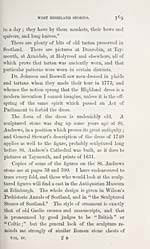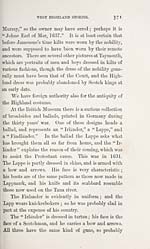Download files
Complete book:
Individual page:
Thumbnail gallery: Grid view | List view

370 CELTIC DRESS.
the time of the Lower Empire. It was found in the
immediate vicinity of St. Andrew's Cathedral, which
was founded by Malcolm IV. a.d. 1159, consecrated
1318, and destroyed after a sermon by Knox in 1560.
The position in which the stone was found indicates
that it was far older than the Cathedral ; and as there
are no Christian symbols on it, I suspect that the
sculptor must have studied art from some Eoman mas-
ter, though he studied design and nature at home.
Apes and lions never frequented the forests of
Caledonia, and these indicate some knowledge of foreign
ways or of foreign design, unless the Eomans exhibited
such creatures in Britain, and the artist saw them there.
Wolves, foxes, dogs, and deer, were clearly familiar to
the sculptor, for they are well done. The men were
probably copied from familiar models, and one of them
(page 38) is dressed in a belted plaid, and armed with
a leaf- headed spear. Another wears a leaf- shaped
sword, and such weapons are referred to a very ancient
period by the best lowland authorities. A third is
figured page 390, and he also wears a belted plaid.
The picture from which the woodcut on page 365
was taken, is at Taymouth, and is a well painted full-
length in oils. From sketches of "Early Scotch His-
tory," page 350, it appears that Jamesone, the Scotch
painter, worked at Taymouth between 1633 and 1641.
In 1635 he executed a family tree, " in which Sir Dun-
can of Lochow, the great ancestor of the family, is re-
presented in a red plaid and kilt, with a shirt of mail,
checked hose, and bare knees."
Mr. Innes does not mention a picture of the "Eegent
the time of the Lower Empire. It was found in the
immediate vicinity of St. Andrew's Cathedral, which
was founded by Malcolm IV. a.d. 1159, consecrated
1318, and destroyed after a sermon by Knox in 1560.
The position in which the stone was found indicates
that it was far older than the Cathedral ; and as there
are no Christian symbols on it, I suspect that the
sculptor must have studied art from some Eoman mas-
ter, though he studied design and nature at home.
Apes and lions never frequented the forests of
Caledonia, and these indicate some knowledge of foreign
ways or of foreign design, unless the Eomans exhibited
such creatures in Britain, and the artist saw them there.
Wolves, foxes, dogs, and deer, were clearly familiar to
the sculptor, for they are well done. The men were
probably copied from familiar models, and one of them
(page 38) is dressed in a belted plaid, and armed with
a leaf- headed spear. Another wears a leaf- shaped
sword, and such weapons are referred to a very ancient
period by the best lowland authorities. A third is
figured page 390, and he also wears a belted plaid.
The picture from which the woodcut on page 365
was taken, is at Taymouth, and is a well painted full-
length in oils. From sketches of "Early Scotch His-
tory," page 350, it appears that Jamesone, the Scotch
painter, worked at Taymouth between 1633 and 1641.
In 1635 he executed a family tree, " in which Sir Dun-
can of Lochow, the great ancestor of the family, is re-
presented in a red plaid and kilt, with a shirt of mail,
checked hose, and bare knees."
Mr. Innes does not mention a picture of the "Eegent
Set display mode to: Large image | Transcription
Images and transcriptions on this page, including medium image downloads, may be used under the Creative Commons Attribution 4.0 International Licence unless otherwise stated. ![]()
| Early Gaelic Book Collections > Blair Collection > Popular tales of the West Highlands > Volume 4 > (386) |
|---|
| Permanent URL | https://digital.nls.uk/76370320 |
|---|
| Shelfmark | Blair.176 |
|---|---|
| Attribution and copyright: |
|
| Description | Orally collected, with a translation by J.F. Campbell. |
|---|---|
| Shelfmark | Blair.173-176 |
| Additional NLS resources: | |
| Description | A selection of books from a collection of more than 500 titles, mostly on religious and literary topics. Also includes some material dealing with other Celtic languages and societies. Collection created towards the end of the 19th century by Lady Evelyn Stewart Murray. |
|---|
| Description | Selected items from five 'Special and Named Printed Collections'. Includes books in Gaelic and other Celtic languages, works about the Gaels, their languages, literature, culture and history. |
|---|

